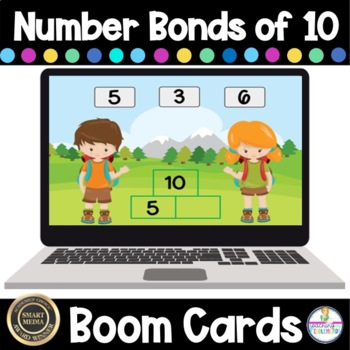- PDF
Description
Addition facts. This set of BOOM cards has 10 digital task cards with number bonds of 10. Students will practice adding and counting. Developing a strong foundation number understanding is crucial.
This Boom Card set is aligned to
Common Core Standards CCSS.MATH.CONTENT.1.OA.C.5
Relate counting to addition and subtraction
CCSS.MATH.CONTENT.1.OA.C.5
Use addition and subtraction within 20
Set Includes:
• 10 Self-Checking Task Cards
Related Products
• Adding 3 Dice Boom Cards Digital Dice Game
• Addition and Subtraction Word Problems Digital Boom Task Cards
• Apple Number Line to 100 Boom Cards
• Build It Base Ten Digital Boom Task Cards
• Counting Fingers to 20 Boom Cards
Boom Cards are FUN and INTERACTIVE digital task cards. They can be used in whole group, small group, or centers/stations. You can even assign it has homework. Your students are going to LOVE it!!
Do I have to prep anything?
No more printing, cutting, and laminating cards. Just assign a Boom Card deck to your students and they do the rest.
What type of device can I use?
They can be viewed on digital devices such as interactive whiteboards, desktops, laptops, netbooks, Chromebooks, iPads, iPhones, Android tablets and phones, and Kindle-Fire tablets.
Do I have to purchase a membership?
No. From Boom Learning: “With your Teachers Pay Teachers purchase, users new to Boom Learning get a three-month free trial of student progress reporting for up to 150 students. Your trial includes the ability to make up to 5 free DIY decks. You may upgrade or cancel at any time. When you redeem your purchase, Boom Learning opens an account for you if you do not already have one. If you do not subscribe at the end of your trial, you will be able to continue using Boom Cards with the Fast Play feature. Fast Play does not track individual progress.”
Can I track data?
Yes, you will be able to track data. The data tracking tool shows you the overall accuracy and speed of an individual’s progress. Please note that you will need to have a membership to track data.
❤️ Follow me! ❤️
Look for the green star next to my TpT store logo and click it to become a follower. This will let you know about my sales, discounts, freebies and new products!
Customer Tips: How to get TPT credit to use on future purchases: *Please go to your My Purchases page. Beside each purchase you'll see a Provide Feedback button. Click Provide Feedback and it will take you to a page where you can give a quick rating and leave a short comment for the product. Each time you give feedback, TPT gives you feedback credits.. You can use these credits to have a discount on future purchases.
Feedback and ratings are greatly appreciated.


